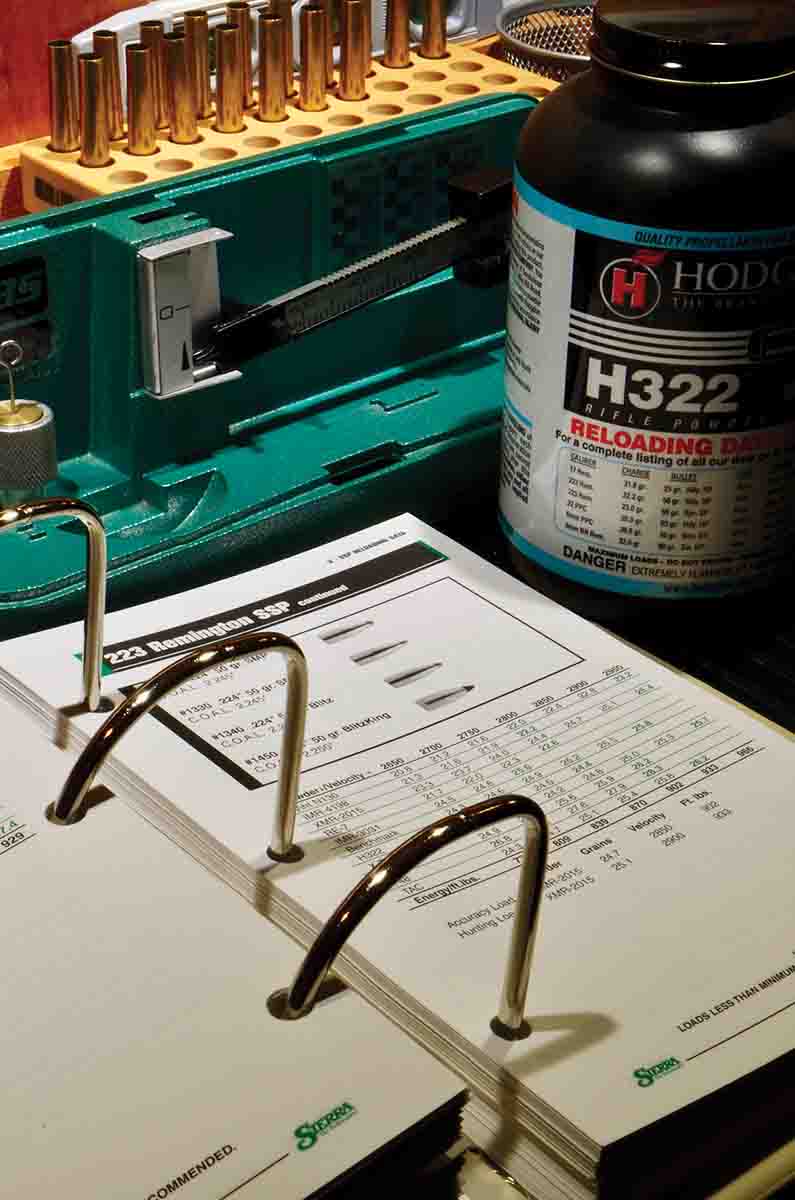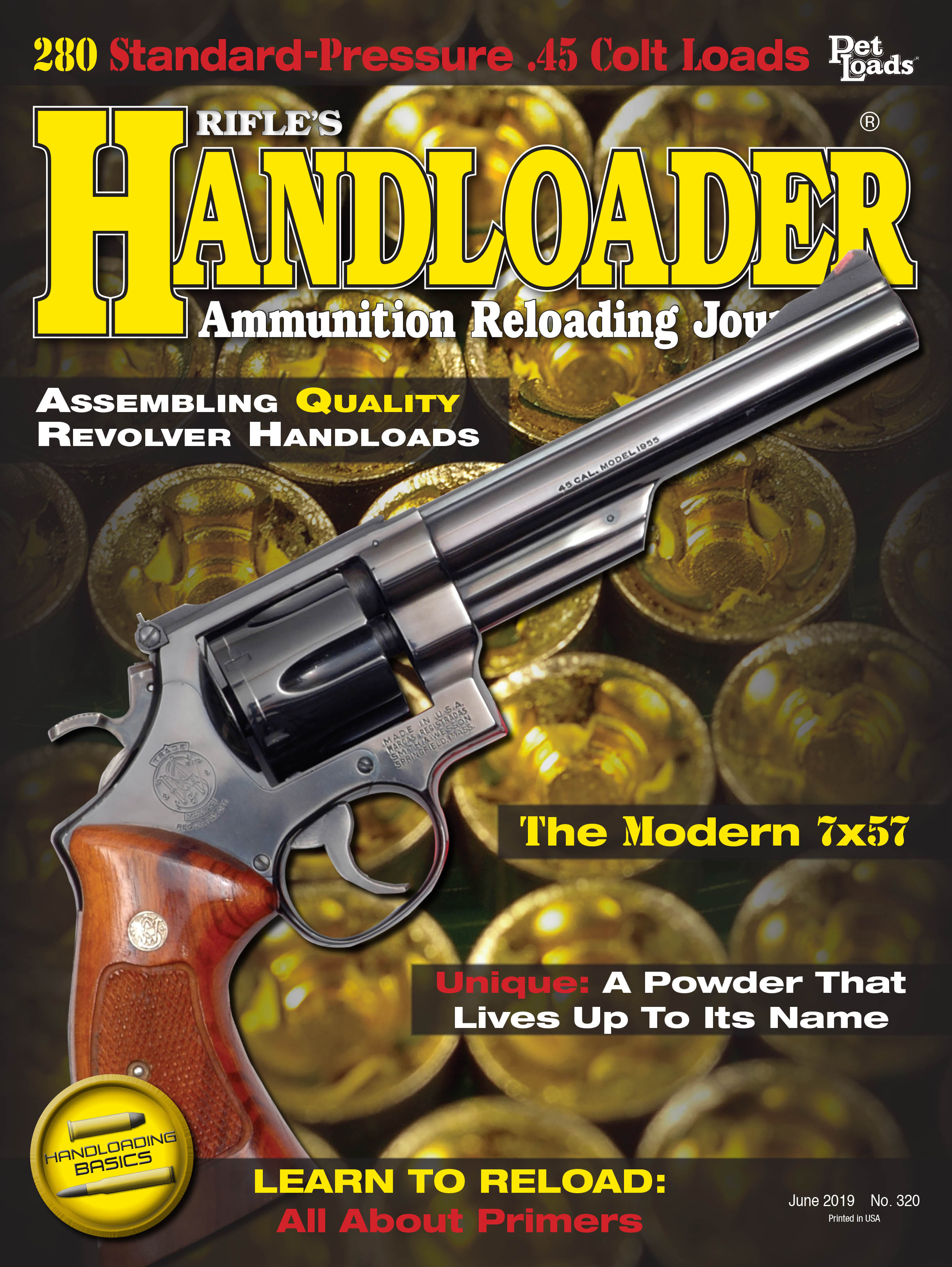In Range
Six Ages of the Handloader
column By: Terry Wieland | June, 19
About 20 years ago, I attended a gathering in South Africa where I met an airline pilot. We fell into a discussion about handloading, which he had taken up a year or two previously. His pet rifle was a custom bolt action in some over-wrought 7mm, ammunition for which was extremely scarce.
Airline pilots are not known for being shrinking violets, and this guy was no exception. Since he could guide a 747 from Johannesburg to Rio, he believed, then anything as primitive as handloading was a breeze. He began telling me about a load he developed using two types of smokeless powder – a so-called “duplex” load – that delivered both higher velocities and tighter groups. When I asked if he had read the warnings about

Right then, I swore never to fly the South Atlantic route on South African. Anyone who would dismiss safety warnings in such a contemptuous manner did not belong at the controls of anything bigger than a bicycle.
As with any endeavor in life, handloaders progress through stages. The first, obviously, is the beginner. This is a guy who has bought the basic tools, read some books (we fervently hope) and is carefully assembling loads using proven formulae. He’s careful not to smoke while he’s doing it and checks every case to make sure he did not double-charge it. His loads are no threat to either the standing benchrest records or the guy on the range next to him.
The next stage is still nervous, but he no longer triple-checks every case, and he’s now loading for several different guns. His powder supply includes three or four types, he keeps a dozen or more different bullets on hand and carefully stores his primers well away from the powder. When someone visits, he’s proud to show them his loading apparatus, and he always keeps the loading manual open to the relevant section when he’s working. In some ways, this is the safest level for all concerned. Alas, like late childhood when you still believe your parents actually know something, it is followed by the teenage years.
With growing confidence, our handloader starts looking for more velocity. If he scans the Internet, he will swiftly find a few loudmouths, hiding behind silly pseudonyms like PowerLoader and VeloKing, who tell him the loading manuals are all lily-livered and that he can safely go far beyond what they show. Cautiously, he begins exceeding maximum loads, first by a bit, later by a lot. He closes his eyes when he pulls the trigger the first time, but when the rifle stays in one piece and the case ejects without a problem, a whole new vista opens up.
As a handloader, he believes he has arrived and begins not only reading the Internet forums but offering a few opinions. When he is welcomed into the fold, he then begins offering similar opinions, face to face and in real life, around his shooting club. He also now owns a chronograph and ostentatiously sets it up in front of his shooting bench every time. If it connects to a laptop, and the laptop to a satellite, all the better.
If handloaders stopped right here, all might be well. Unfortunately, confidence leads inexorably to overconfidence. This is the stage of stiff bolt handles and flattened primers, of velocities written in red ink in the loading log and of triumphant posts on Internet forums. So far, however, nothing has come apart in his hands and both eyes are intact. Once or twice, he has seen smoke curling from the chamber when the bolt was finally pried open, and once maybe a blown primer ended up in the magazine well.
With actions like the Remington 700 or Ruger 77, these things can happen occasionally with no real damage except a bad scare. They are strong and dependable and, although I hesitate to put it in writing, capable of withstanding pressures well beyond SAAMI standards. However, just because a car will do 100 mph, that’s no reason to push it on a winding country road.
This is where some handloaders cross the line. This is where cars fly off the road at Dead Man’s Curve. We have now reached the most dangerous stage of a handloader’s career: Arrogant carelessness.
The signs are obvious. The loading bench has two or three types of powder sitting on it at one time, or there is powder in the measure but no container to remind you what it is. Such precautions are not needed because, hey, our boy is experienced enough that he can tell 3031 from 4350 at a glance. He never uses any but magnum primers, and now any case that emerges from the chamber without a flattened primer is just not hot enough. The newer tools consist of various apparatus for compressing powder charges – vibrators to shimmy the case and settle the grains, and drop tubes 2-feet long.
At this point, no one wants to use the shooting bench next to his, or even be on the range at the same time. It’s not so much that they’re afraid his rifle will come apart (although that’s a possibility) or that they are tired of listening to him brag about velocities or his quarter-inch groups. (These, by the way, only occur when no one else is around.) No, it’s that they’re tired of having him ask about their rifle, their cartridge and their velocities just to give him an excuse to embark on a long analysis of what they’re doing wrong.
This, more or less, is the stage at which I found our aforementioned airline pilot, although I think he skipped over a couple of the more prudent levels along the way. This is where, despite all warnings to the contrary, our man starts experimenting with duplex, or even triplex, loads. (Yes, triplex!) This is the point where, instead of consulting a loading manual that has been assembled very carefully by experts, our second-to-last-stage handloader starts employing logic instead. If such-and-such a powder works in this case with 400-grain bullets, then the starting load should work just as well with 500-grain bullets. Right? The fact that the very same manual, in its section on 500-grain bullets, does not mention this powder in any way should be a hint. But no. And this is where floorplates fly open, primers end up in magazine wells, scope reticles spring loose and curl up like fishhooks, and tendrils of smoke emerge from the chamber.
In most cases, if we started with a man of average intelligence and judgment, this marks the transition to the final stage. Some would call it sensible. I call it fearful. Having had a good scare, you suddenly resolve never to try such a thing again. You send the rifle to a gunsmith to have the headspace checked and, if necessary, the barrel turned in a twist and rechambered; you send the scope to the manufacturer to have the reticle refitted. You sit and stare into the distance and thank your lucky stars that you still have all body parts intact, that no one else was hurt and there was no lasting damage.
Handloading is a bit like driving from New York to Los Angeles. There are many routes available, and not everyone stops in the same places, but the end result is the same. The fervent hope is that you do arrive safely and not end up in a flaming wreck at the bottom of a canyon.


